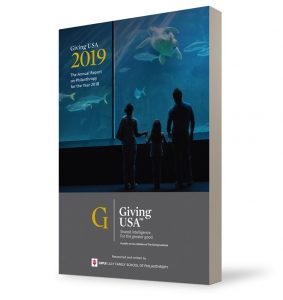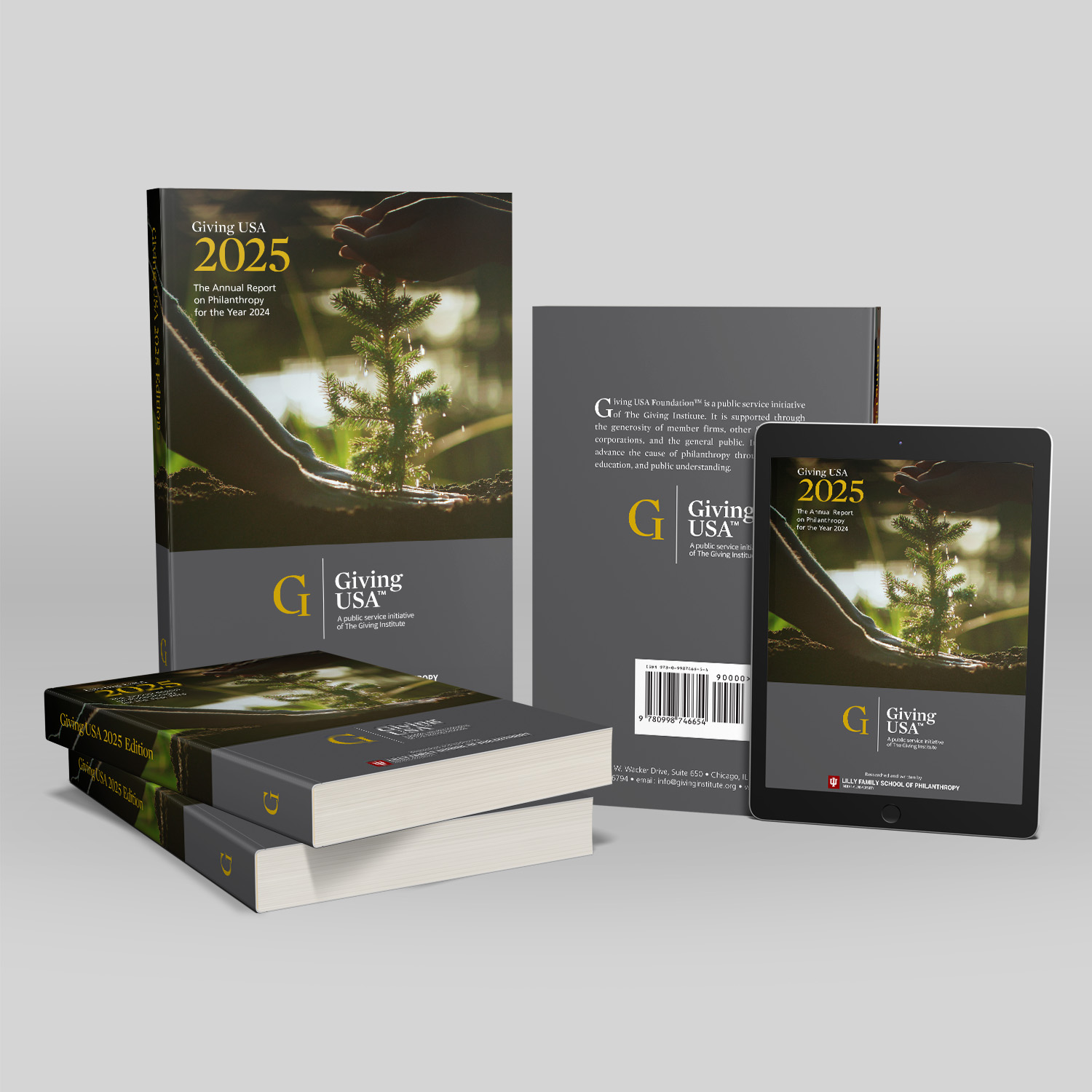
Shaped by a mixture of countervailing economic and policy factors, total contributions grew 0.7% in current dollars, declined 1.7% adjusted for inflation
CHICAGO [June 18, 2019] — Amid a complex climate for charitable giving, American individuals, bequests, foundations and corporations gave an estimated $427.71 billion to U.S. charities in 2018, according to Giving USA 2019: The Annual Report on Philanthropy for theYear 2018.
Total charitable giving rose 0.7% measured in current dollars over the revised total of $424.74 billion contributed in 2017. Adjusted for inflation, total giving declined 1.7%. (Please see below for a more detailed breakdown of the numbers for each philanthropic source and sector.)
Giving USA, the longest-running and most comprehensive report of its kind in America, is published by Giving USA Foundation, a public service initiative of The Giving Institute. It is researched and written by the Indiana University Lilly Family School of Philanthropy at IUPUI.
“After reaching record-breaking levels of giving in 2017, American individuals and organizations continued their generous support of charitable institutions in 2018,” said Rick Dunham, chair of Giving USA Foundation and CEO of Dunham + Company. “However, the environment for giving in 2018 was far more complex than most years, with shifts in tax policy and the volatility of the stock market. This is particularly true for the wide range of households that comprise individual giving and provide over two-thirds of all giving.”
A number of competing factors in the economic and public policy environments may have affected donors’ decisions in 2018, shifting some previous giving patterns. Many economic variables that shape giving, such as personal income, had relatively strong growth, while the stock market decline in late 2018 may have had a dampening effect. The policy environment also likely influenced some donors’ behavior. One important shift in the 2018 giving landscape is the drop in the number of individuals and households who itemize various types of deductions on their tax returns. This shift came in response to the federal tax policy change that doubled the standard deduction. More than 45 million households itemized deductions in 2016. Numerous studies suggest that number may have dropped to approximately 16 to 20 million households in 2018, reducing an incentive for charitable giving.
“The complexity of the charitable giving climate in 2018 contributed to uneven growth among different segments of the philanthropic sector. Growth in total giving was virtually flat. Contributions from individuals and their bequests were not as strong as in 2017, while giving by foundations and corporations experienced healthy growth,” said Amir Pasic, Ph.D., the Eugene Tempel Dean of the Lilly Family School of Philanthropy. “Charitable giving is multi- dimensional, however, and it is challenging to disentangle the degree to which each factor may have had an impact. With many donors experiencing new circumstances for their giving, it may be some time before the philanthropic sector can more fully understand how donor behavior changed in response to these forces and timing.”
The overall U.S. economy was relatively strong in 2018, lifted by the robust performance of many of the economic factors that affect giving, such as a 5.0% increase in disposable personal income and 5.2% growth in the GDP, both in current dollars. Giving by foundations and giving by corporations were buoyed by the strong run of the stock market in the past few years. Individual giving declined.
“As we’ve seen in previous years, the strong economy had a positive influence on individual giving; however, these positive effects may have been tempered by policy changes and other factors to create a more mixed picture for giving in 2018. About half of all Americans give, and the tax policy changes may have created uncertainty for some donors, especially those who previously itemized but no longer will,” said Una Osili, Ph.D., associate dean for research and international programs at the Lilly Family School of Philanthropy. “We have strong historical data about the link between economic variables, the stock market and charitable giving, and we will be analyzing data for the next few years to better understand how broad giving patterns may have changed.”
Highlights about Charitable Giving by Source
- Giving by foundations had a record-breaking year, reaching its highest-ever dollar amount even when adjusted for inflation, and growing to its largest share (18%) of total giving to date in 2018.
- Giving by individuals decreased as a percentage of total giving in 2018 to 68% (down from 70% in 2017), despite achieving its third-highest total dollar amount on record, adjusted for inflation.
- Giving by corporations experienced solid growth in 2018. This type of giving is highly responsive to changes in corporate pre-tax dollars and GDP, and its year-over-year trend lines tend to be more turbulent as a result.
- Giving by bequest did not keep pace with inflation.
The Numbers for 2018 Charitable Giving by Source:
↓ Giving by individuals totaled an estimated $292.09 billion, declining 1.1% in 2018 (a decrease of 3.4%, adjusted for inflation).
↑ Giving by foundations increased by an estimated 7.3%, to $75.86 billion in 2018 (an increase of 4.7%, adjusted for inflation). Data on foundation giving are provided by Candid (formerly known as the Foundation Center).
= Giving by bequest totaled an estimated $39.71 billion in 2018, remaining flat with a 0.0% increase from 2017 (a 2.3% decline, adjusted for inflation).
↑ Giving by corporations is estimated to have increased by 5.4% in 2018, totaling $20.05 billion (an increase of 2.9%, adjusted for inflation).
“Giving by foundations represented 18% of all charitable dollars given in 2018—an unprecedented dollar amount and an unprecedented share of total giving. The strong growth in giving by foundations and in giving by corporations helped bolster total giving overall in 2018,” said Rachel Hutchisson, chair of The Giving Institute, and vice president of corporate citizenship and philanthropy for Blackbaud. “These results highlight the importance of institutions to the philanthropic landscape, and serve as a reminder that different types of approaches to philanthropy are vital for strengthening and expanding the field, especially in complex years like this one.”
Highlights about 2018 Giving to Charitable Organizations
- Charitable sectors saw uneven growth in 2018 in current dollars, with two categories of recipient organizations growing, three categories staying relatively flat, and four categories declining.
- Some of the categories of charitable organizations that had declines in 2018, including giving to education and giving to foundations, experienced strong growth in 2017, even when adjusted for inflation. It is not unusual for strong growth in giving one year to be followed by slower growth or a decline in the following year, especially in terms of inflation-adjusted dollars.
- Giving to the public-society benefit subsector decreased in 2018 after eight years of consecutive growth. Similarly, giving to religion declined in 2018 after six years of slow growth and one year of flat growth in inflation-adjusted dollars in 2017
- Giving to human services, health, and arts, culture and humanities organizations stayed relatively flat in 2018 in current dollars, and did not keep pace with inflation
- International affairs and environment and animal organizations were the two types of recipient organizations that experienced substantial growth in giving in 2018.
“Despite declines in 2018, many subsectors experienced their second-best year for giving ever, when adjusting for inflation,” said Laura MacDonald, vice-chair of Giving USA Foundation and founder of Benefactor Group. “We know that there are organizations in each of these subsectors that found success in 2018, as well as organizations that faced challenges. The chapters of the report offer greater context for understanding how some groups are continuing to raise charitable dollars even when some donors are facing new giving conditions. Now, as always, it is vital for organizations to understand the forces impacting their foundation, corporate and individual donors.”
The Numbers for 2018 Charitable Giving to Recipients:
↓ Giving to religion is estimated to have declined by 1.5% (a decrease of 3.9% adjusted for inflation), receiving $124.52 billion in contributions.
↓ Giving to education is estimated to have declined by 1.3% (decreasing 3.7% adjusted for inflation), to $58.72 billion.
= Giving to human services is estimated to have stayed relatively flat, decreasing by 0.3% (a decrease of 2.7% adjusted for inflation), totaling $51.54 billion.
↓ Giving to foundations is estimated to have decreased by 6.9% (declining by 9.1% adjusted for inflation) to $50.29 billion, based on data provided by Candid.
= Giving to health organizations is estimated to have had flat growth of 0.1% (a decline of 2.3% adjusted for inflation) at $40.78 billion.
↓ Giving to public-society benefit organizations decreased by an estimated 3.7% (decreasing 6.0% adjusted for inflation), to $31.21 billion.
= Giving to arts, culture, and humanities is estimated to have stayed relatively flat, increasing 0.3% (declining 2.1% adjusted for inflation) to $19.49 billion.
↑ Giving to international affairs is estimated to have increased by 9.6% (an increase of 7.0% adjusted for inflation), to $22.88 billion.
↑ Giving to environment and animal organizations is estimated to have increased 3.6% (an increase of 1.2% adjusted for inflation), to $12.70 billion.
“The range of results in giving to charitable organizations reflects a blend of factors that are specific to 2018 and factors that are longer-term trends. For instance, giving to religion, which is comprised largely of donations by individuals, declined in 2018. That decline follows trends in individual giving, but the decline is likely aided by a number of other factors, such as the growing number of Americans who are not affiliated with a religious group,” said Patrick M. Rooney, Ph.D., executive associate dean for academic programs at the Lilly Family School of Philanthropy. “In addition, giving to environment and animals, the smallest category of giving to charitable organizations, has grown for five consecutive years. Giving to environment and animal organizations reached an all-time high in 2018.”
In addition, giving to individuals, which is 2% of total giving, is estimated to have declined 2.6% (4.9% in inflation-adjusted dollars) in 2018, to $9.06 billion. The bulk of these donations are in- kind gifts of medications to patients in need, made through the patient assistance programs of pharmaceutical companies’ operating foundations.
Unallocated giving was $6.53 billion in 2018. This amount can be considered the difference between giving by source and use in a particular year. It includes the difference between itemized deductions by individuals (and households) carried over from previous years. The tax year in which a gift is claimed by the donor (carried over) and the year when the recipient organization reports it as revenue (the year in which it is received) may be different.
NOTES TO EDITORS
Members of the media can request 40-year data tables that show sources of contributions by year in current and inflation-adjusted dollars, and allocation of gifts by type of recipient category, also in current and inflation-adjusted dollars. Data also are available showing total giving as a percentage of GDP, individual giving as a percentage of disposable income and corporate giving as a percentage of corporate pre-tax profits.
The requested citation for Giving USA is Giving USA 2019: The Annual Report on Philanthropy for the Year 2018, a publication of Giving USA Foundation, 2019, researched and written by the Indiana University Lilly Family School of Philanthropy. Available online at www.givingusa.org.
About Giving USA Foundation™
Advancing the research, education and public understanding of philanthropy is the mission of Giving USA Foundation, founded in 1985 by The Giving Institute. Headquartered in Chicago, the Foundation publishes data and trends about charitable giving through its seminal publication, Giving USA, and shorter Special Reports, released periodically, providing in-depth explorations on today’s charitable giving topics. Published since 1956, Giving USA is the longest running, most comprehensive report on philanthropy in America.
About Giving USA
For over 60 years, Giving USA: The Annual Report on Philanthropy in America, has provided comprehensive charitable giving data that are relied on by donors, fundraisers and nonprofit leaders. The research in this annual report estimates all giving to charitable organizations across the United States. Giving USA is a public outreach initiative of Giving USA Foundation and is researched and written by the Indiana University Lilly Family School of Philanthropy. Giving USA Foundation, established in 1985 by The Giving Institute, endeavors to advance philanthropy through research and education. Explore Giving USA products and resources, at www.givingusa.org.
About The Giving Institute
The Giving Institute, the parent organization of Giving USA Foundation, consists of member organizations that have embraced and embodied the core values of ethics, excellence and leadership in advancing philanthropy. Serving clients of every size and purpose, from local institutions to international organizations, The Giving Institute member organizations embrace the highest ethical standards and maintain a strict code of fair practices. For information on selecting fundraising counsel, visit www.givinginstitute.org.
How to Obtain Giving USA 2019
Giving USA 2019: The Annual Report on Philanthropy for the Year 2018 is available for download at www.givingusa.org.
Customers can select from a number of Giving USA 2019 products, including the full report, available in paperback or digital download packages; a new, condensed version of the report called Key Findings; a comprehensive PowerPoint slide deck with talking points; data tables; and the free Infographic.
Giving USA Foundation periodically publishes in-depth reports (Special Reports) on different aspects of charitable giving and fundraising trends. Visit www.givingusa.org for available topics.
About the Indiana University Lilly Family School of Philanthropy
The Indiana University Lilly Family School of Philanthropy at IUPUI is dedicated to improving philanthropy to improve the world by training and empowering students and professionals to be innovators and leaders who create positive and lasting change. The school offers a comprehensive approach to philanthropy through its academic, research, and international programs and through The Fund Raising School, Lake Institute on Faith & Giving, the Mays Family Institute on Diverse Philanthropy and the Women’s Philanthropy Institute. For more information, visit philanthropy.iupui.edu.
Giving USA Methodology
Giving USA estimates primarily rely on econometric methods developed by leading researchers in philanthropy and the nonprofit sector and are reviewed and approved by members of the Giving USA Advisory Council on Methodology (ACM). Members of the ACM include research directors from national nonprofit organizations, as well as scholars from such disciplines as economics and public affairs, all of whom are involved in studying philanthropy and the nonprofit sector.
The Indiana University Lilly Family School of Philanthropy prepares all of the estimates in Giving USA for Giving USA Foundation. Giving USA develops estimates for giving by each type of donor (sources) and for recipient organizations categorized by subsectors (uses). Most of Giving USA’s annual estimates are based on econometric analyses and tabulations of tax data, economic indicators and demographics. Data for giving by foundations come from Candid (formerly the Foundation Center).
Following the same approach used by leading public and private institutions that develop economic statistics, Giving USA researchers update data found within Giving USA each year. This is because current Giving USA estimates are developed before final tax data, some economic indicators and some demographic data are available. The estimates are revised and updated as final versions of these data become available. Final estimates are usually developed two or three years after their initial release.
For more specific details on Giving USA’s methodology, please refer to the “Brief summary of methods” section within Giving USA 2019 or contact the Indiana University Lilly Family School of Philanthropy at [email protected] or 317-278-8972.
Media Contacts:
FOR the FOUNDATION:
Casey Blickenstaff, 312-558-1770 [email protected]
FOR the SCHOOL:
Adriene Davis Kalugyer, 317-278-8972
[email protected]


